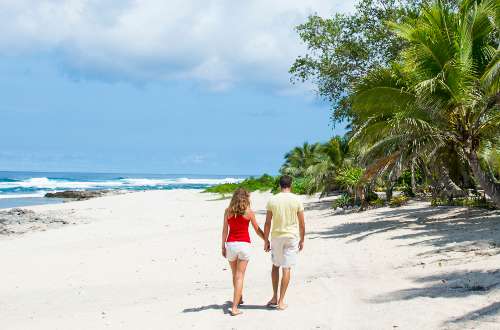
Richard Butler | Centre For Aviation CAPA | Aug 9th, 2019
Air Vanuatu is on the verge to expand it’s tourism industry and dominate the tourism sector by 2030 and to make Vanuatu the future number one tourism sector for visitor’s all around the globe.
Vanuatu’s aviation market will undergo a major transformation over the next few years as its flag carrier pursues rapid expansion to support a booming tourism industry. Air Vanuatu expects to triple its passenger traffic by 2030 as visitor numbers quadruple.
In Feb-2019 Air Vanuatu placed an order for four Airbus A220s, which are slated to be delivered from 2020 to 2022. The A220s will partially replace larger 737s, but international seat capacity will grow significantly as frequencies to existing destinations are bolstered and new destinations are launched.
The airline also plans to expand its ATR 72 fleet and renew its fleet of small regional aircraft, resulting in significant domestic capacity increases. A larger domestic operation is needed as tourism is developed on smaller islands, aided by infrastructure investments.
Visitor numbers to Vanuatu grew by nearly 30% from 2015 to 2018, driven partially by rapid expansion from China and other Asian source markets. Asia is expected to continue driving rapid growth over the next several years, but as direct flights to Asia are unlikely, Air Vanuatu is focusing on improving connectivity to the main gateways of Oceania.
Summary
- Air Vanuatu is planning major expansion over the next several years as tourism in Vanuatu grows rapidly.
- Air Vanuatu is acquiring at least four A220s for delivery from 2020, which will be used to launch new routes and boost frequencies on routes now served with 737s.
- Frequency increases to major airports in the Oceania region are important to improve connections to flights to Asia, which is Vanuatu’s fastest growing source market.
- Air Vanuatu is also planning to grow its domestic operation by expanding its ATR fleet, renewing its small regional aircraft fleet, and using A220s on domestic trunk routes.
- Air Vanuatu operates to 27 airports in Vanuatu and the government is committed to doubling the number of airports with paved runways from three to six to enable service with ATR 72s and A220s.
Air Vanuatu CEO Derek Nice discusses the small flag carrier’s recent A220 order, plans for expanding the turboprop fleet, expected improvements in connectivity, the anticipated growth of tourism in Vanuatu, and the airline’s corresponding projected growth rate.
Vanuatu relies heavily on tourism
Vanuatu is a small island country in the South Pacific known for its beaches, coral reefs and adventure tourism.
It has a population of only 300,000 spread across more than 80 islands, and attracts slightly more than 100,000 visitors per year. Travel and tourism are critical to the Vanuatu economy, accounting for nearly half of the country’s GDP.
Air Vanuatu plays a critical role in supporting tourism and the overall economy. Air Vanuatu is the Vanuatu’s only domestic airline and has a domestic network of 27 airports.
There are only two international airports and only the capital Port Vila is served by foreign airlines.
Port Vila is served by only five foreign airlines – Aircalin, Air Niugini, Fiji Airways, Solomon Airlines and Virgin Australia – which combined account for approximately one third of international seat capacity.
Vanuatu international seat capacity by airline: week commencing 5-Aug-2019
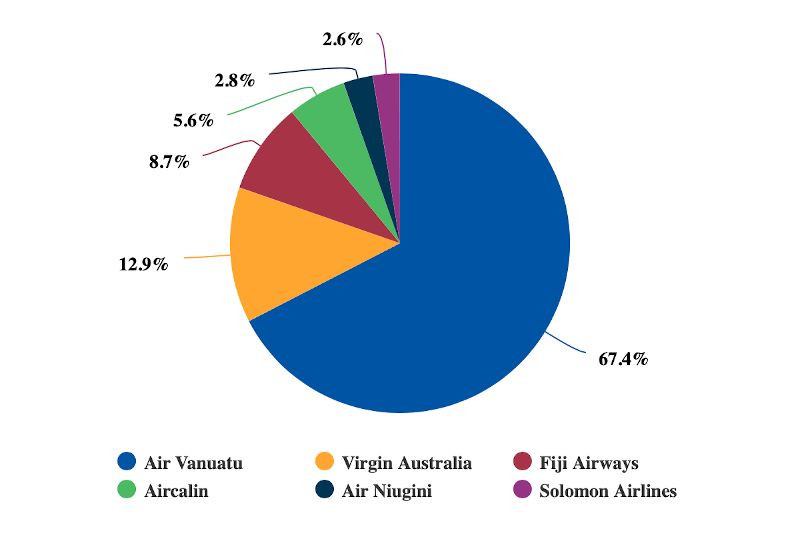
Vanuatu’s international market has grown rapidly the past three years
Annual international seat capacity at Vanuatu is projected to exceed 500,000 seats for the first time in 2019. This represents growth of slightly more than 40% compared to 2016.
Weekly international seat capacity is approximately 11,000 weekly seats in Aug-2019, representing growth of nearly 40% compared to Aug-2016.
Air Vanuatu currently generates approximately 7,000 weekly international seats, which represents a 40% increase compared to Aug-2016. It currently operates 26 weekly international return services compared to only 17 weekly fights in Aug-2016 (based on OAG schedule data).
Foreign airlines have only 15 weekly services in the Vanuatu market
Foreign airlines currently operate 15 weekly services to Vanuatu, consisting of seven from Fiji Airways, four from Virgin Australia, two from Aircalin, one from Air Niugini and one from Solomon Airlines.
Fiji Airways has the only daily service, having upgraded Nadi-Port Vila to daily earlier this year. It uses ATR 72s on the short route.
Aircalin has maintained the same schedule at Port Vila for several years, operating two weekly A320 flights from its Noumea hub for most of the year. (There are short periods each year where this route is served with one or three weekly frequencies).
Solomon Airlines has maintained a schedule of one weekly A320 flight from its base in Honiara for the past several years.
Air Niugini launched services to Port Vila via the Solomon Islands in 2015 and currently operates one weekly service with 737-800s. Air Niugini had two weekly services on the Port Moresby-Honiara-Port Vila route for most of 2017 and 2018, before downgrading the route back to once weekly in Oct-2018.
Virgin Australia currently operates four weekly frequencies from Brisbane with 737-800s. Virgin has had relatively flat capacity to Vanuatu in recent years, operating three to five weekly services, depending on the time of year.

Air Vanuatu expands in Australia
Australia is Air Vanuatu’s largest international market and currently accounts for slightly more than two thirds of its international seat capacity.
Australia has also been Air Vanuatu’s primary market for expansion in recent years. Its current schedule of 15 weekly services to Australia (seven to Sydney, five to Brisbane and three to Melbourne) is an all-time high.
Three years ago, in Aug-2016, Air Vanuatu had just eight weekly services to Australia (two to Brisbane and six to Sydney). Four years ago, in Aug-2015, it had only six weekly services (two to Brisbane and four to Sydney).
Only the Port Vila-Brisbane route is competitive as it is served by Virgin Australia. Air Vanuatu upgraded Sydney to daily in Jun-2018 and Melbourne was launched with three weekly services in Jun-2019.
Melbourne was suspended in Jul-2015, but the previous service had been limited to only one weekly seasonal frequency. Port Vila-Melbourne is Air Vanuatu’s longest route, at nearly five hours.
One of Air Vanuatu’s Brisbane frequencies operates from Espiritu Santo, which is Vanuatu’s only other international airport. This is the only scheduled international service from Espiritu Santo.
Air Vanuatu one-way weekly frequencies to Australia: Sep-2011 to Jan-2020

Air Vanuatu has also expanded in New Zealand by adding frequencies on the Port Vila-Auckland route. In June-2019 it upgraded Auckland to six weekly services. Previously Auckland was served with three to four weekly services.
Air New Zealand suspended services to Port Vila in early 2016.
Air Vanuatu has only two international markets in the South Pacific
New Caledonia and Fiji are Air Vanuatu’s only international destinations in the South Pacific.
Noumea (NOU) in New Caledonia is served with four weekly return services (eight departures in total) and Nadi (NAN) in Fiji is served with only one weekly return service (two departures in total).
Air Vanuatu international routes ranked by weekly departures: week commencing 5-Aug-2019
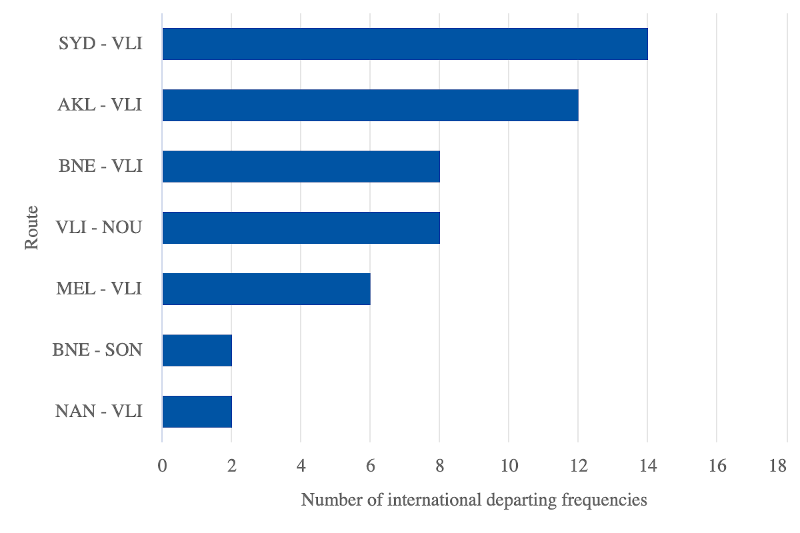
Air Vanuatu has twice as many frequencies on the Port Vila-Noumea route as Aircalin but Aircalin has slightly more capacity as it uses A320s, whereas Air Vanuatu uses ATR 72s. Over the past several years Air Vanuatu has served Noumea with four weekly frequencies for most of the year and slight decreases or increases during brief periods.
Air Vanuatu and Fiji Airways both use ATR 72s on the Port Vila-Nadi route, but Air Vanuatu has significantly less capacity because of its limited schedule. Air Vanuatu has been in and out of the Fiji market over the years and has never operated a high frequency service.
Air Vanuatu to replace wet leased 737 with A220
All of Air Vanuatu’s international routes are operated with 737s except Port Vila to Noumea and Nadi, which are served with the ATR 72.
Air Vanuatu currently operates one 70-seat ATR 72-600 and also has only one 737 under its operator’s certificate – a three-year old 170-seat two class 737-800.
Air Vanuatu has historically supplemented its 737 fleet with a wet leased 737. It currently wet leases a 130-seat two class 737-300 from Air Nauru, which is being deployed to Auckland and Brisbane. Its 737-800 is currently deployed on the Melbourne and Sydney routes (according to Flightradar24 data).
Air Vanuatu CEO Derek Nice told CAPA TV on the sidelines of the 4-Jun-2019 CAPA CEOs in Seoul Summit that the airline’s first A220 will be used to replace its wet leased 737. Air Vanuatu expects to receive its first A220 in Jun-2020, enabling it to stop relying on wet leased capacity.
Air Vanuatu expects to receive a second A220 in Oct-2020. Mr Nice said the second A220 will be used to increase frequencies to existing destinations (particularly Brisbane) and to replace the ATR 72 on regional international services (Nadi and Noumea).
Downgauging 737 routes is a sensible strategy
On the ATR 72 routes the A220 will result in 54% more seat capacity and a better service for passengers.
On the 737 routes the A220 represents a downgauging, as the seat capacity per flight declines by up to 36% (depending on the variant of 737 and A220). However, an increase in frequencies will enable Air Vanuatu to maintain, or even increase, capacity.
“I think the A220 will be transformative for us”, Mr Nice said, adding that the 170-seat 737-800 “constrains our ability to offer connectivity because we are limited by the number of frequencies that we can offer in most of our markets simply because the aircraft is so large”.
He added: “The A220 with either 108 seats or 133 is right size for most of our markets. So it allows us to increase frequency”.
Of the four A220s Air Vanuatu has ordered, two are A220-100s and two are A220-300s.
Both types will have eight business class seats, providing the same premium capacity as the 737-800. Air Vanuatu is configuring the A220-100 with 100 economy seats and the A220-200 with 125 economy seats, compared with 162 economy seats on its 737-800.
New destinations planned with the A220
Mr Nice said Christchurch in New Zealand and Adelaide, Australia, are among potential new destinations that may be launched with the A220. New island destinations within the South Pacific region are also possible.
Air Vanuatu should have plenty of opportunity to grow its network as the third and fourth A220s are delivered.
Its third A220 is slated to be delivered in 2021, followed by the fourth aircraft in 2022. Mr Nice said these are both earmarked as growth aircraft; they will give the airline a further increase in frequencies to existing destinations and enable it to launch new destinations.
Air Vanuatu also has options or purchase rights for additional A220s as part of the commitment with Airbus that was announced in Feb-2019.
If those are exercised, the optioned aircraft would drive further capacity growth in 2023 and beyond. “We will see how we are performing and if we are following business plan then we would be able to confirm those optioned aircraft for 2023 and beyond”, Mr Nice explained.
Air Vanuatu expects to triple passenger traffic by 2030
Air Vanuatu’s new business plan envisages annual growth of approximately 10% over the next several years and a tripling of passenger traffic by 2030. The airline currently carries 500,000 to 600,000 passengers per annum.
At the moment Air Vanuatu has an approximately 50/50 split of domestic and international passenger traffic.
“We see that balance continuing as the domestic grows very substantially as well but probably we will be more international than domestic in the years to come”, Mr Nice said.
Most of the international growth is expected to occur in the inbound market, although some outbound growth is also anticipated as more Vanuatu residents travel overseas. Only 20% of Air Vanuatu’s traffic currently originates in Vanuatu.
Of the 80% of passengers that originate outside Vanuatu, two thirds are from other countries in Oceania (includes other Pacific island countries as well as Australia and New Zealand). The other one third – or approximately one quarter of total passenger traffic – are from long haul markets outside the Oceania region.
Long haul traffic to Vanuatu is growing rapidly
The long haul inbound segment has been the one growing fastest in recent years and is expected to be the main driver of future growth, although Air Vanuatu also expects growth in the outbound segment and sixth freedom transit traffic.
Air Vanuatu serves the long haul segment by offering connections at major Oceania hubs – primarily Auckland, Brisbane, Sydney and Nadi.
Nadi is convenient for accessing flights to North America, while Auckland, Brisbane and Sydney are the best options for Asia.
Asia, and particularly China, has been the fastest growing market for Vanuatu in recent years – albeit on a very small base. Mr Nice said that traffic from Asia to Vanuatu had been growing at approximately a 12% rate over the past five to six years, whereas traffic from Europe had been growing at a rate of 7.5% per annum, and traffic from North America at 5%.
“Demand for travel to Vanuatu is increasing very rapidly”, Mr Nice said. “We think the constraint right now is connectivity. As we solve that problem with more capacity we think that growth will continue or may even accelerate.”
China and Asia make up Vanuatu’s fastest growing source market
As connectivity to long haul markets improves Air Vanuatu expects its passenger mix will change, with more traffic being composed of passengers out of Asia and, to a lesser extent, passengers out of North America and Europe.
Australia is Vanuatu’s largest source market by a wide margin, accounting for 61,000, or 52%, of total visitors in 2018.
However, while Australian visitor numbers have been on the rise since 2015, they are still below historic levels – Australian visitor numbers peaked at 65,000 in 2009 and again in 2012 and 2013.
New Zealand visitor numbers peaked in 2014 – at 16,000 – before declining in 2015 and 2016. Although New Zealand visitor numbers have again been on the rise in the past three years, they are still below 2016 levels.
China has emerged as Vanuatu’s fourth largest source market after Australia, New Caledonia and New Zealand. Chinese visitor numbers have increased from a base of only 600 in 2012 to 4,000 in 2018.
Chinese visitor arrivals to Vanuatu and year-over-year growth: 2011 to 4M2019
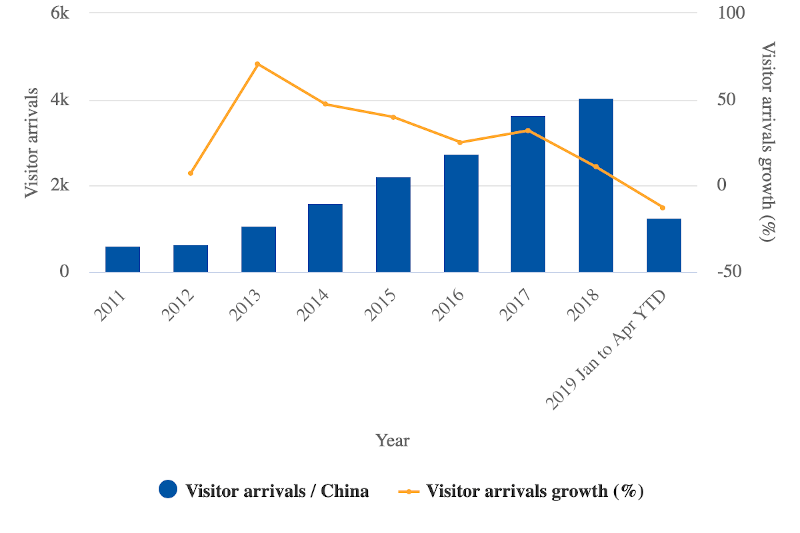
Chinese visitor numbers expected to increase tenfold over the next decade
While 4,000 visitors from China is still a small figure, it is significant, given the small size of Vanuatu. The Vanuatu tourism industry is expecting an influx of Chinese tourists over the next several years.
Mr Nice said Chinese visitor numbers are projected to increase tenfold over the next 10 years. In terms of dollars spent, he expects that China will overtake Australia as the largest source market for Vanuatu and will also “challenge Australia in terms of passenger numbers or tourism arrivals”.
Vanuatu also expects a surge in visitors from other Asian countries, including Japan. There are currently only approximately 1,000 Japanese visitors per year to Vanuatu, but the number was even smaller – around 600 – in 2015.
Japan is the one of the largest source market for Vanuatu, despite the low numbers. This an indication of the small size of the overall Vanuatu market and how dominating its three main short haul markets (Australia, New Caledonia and New Zealand) have historically been.
Vanuatu’s leading source markets ranked by % of total visitors: 2018
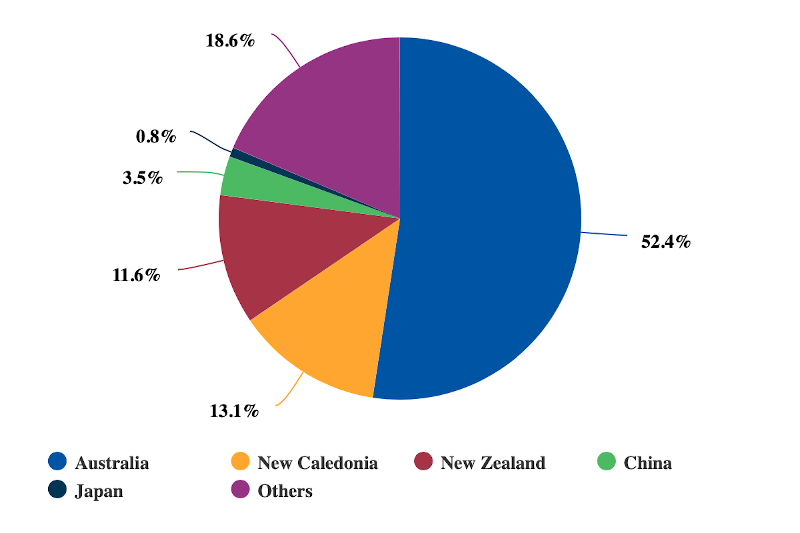
The 18.6% assigned to the “others” category in the pie chart above is made up of 6.9% for Europe, 2.9% for North America, 5.7% for South Pacific island countries besides New Caledonia and 3.1% for other regions (mainly Asia excluding China and Japan).
Asia overall accounts for less than 7% of total visitors; besides China and Japan there has been growth in recent years from India and South Korea, but on a tiny base.
Air Vanuatu is promoting packages to Asian tourists that combine multiple countries in the South Pacific. Multi-stop itineraries have become increasingly popular as the region overall is a hot destination for Chinese and other residents of other Asian countries.
“The entire region is seeing massive growth in the inbound tourism market out of Asia and China in particular”, Mr Nice said. “That wave hit Australia and New Zealand a few years ago and now it has moved on to Vanuatu and the other islands in the South Pacific.”
Vanuatu visitor numbers are again on the rise
In 2013 total visitor numbers to Vanuatu reached a peak with 110,000 visitors, but declined in 2014 and 2015.
Growth has regained momentum since 2015 and Vanuatu set a new visitor arrival record in 2018 when it recorded 116,000 visitors.
Visitor numbers and year-over-year growth: 2011 to 4M2019

The Vanuatu government has set a target of 450,000 visitors by 2030. Asia will be the main driver – including China and newer source markets, such as India – but Vanuatu also expects continued growth from Europe and North America.
Air Vanuatu is supporting the government’s tourism aspirations by expanding its fleet to support a tripling in its passenger traffic by 2030. Other stakeholders, such as hotels and tour operators, are also involved in Vanuatu’s tourism push as there is a recognition that infrastructure needs to be improved in order to achieve the growth targets.
Foreign airline expansion is likely, but may not be significant
Vanuatu’s rise in popularity as a tourist destination will likely also attract foreign airlines. However, the small size of the market will make it difficult to attract Asian carriers – even with a partnership from Air Vanuatu, which is keen to attract and work with Singapore Airlines.
Expansion by existing competitors and the potential resumption of services from Air New Zealand are more likely.
Air Vanuatu has limited competition as it codeshares with four of the five foreign airlines serving Port Vila – Air Niugini, Aircalin, Fiji Airways and Solomon Airlines.
Virgin Australia is the only airline serving Port Vila that Air Vanuatu does not partner, but Air Vanuatu has a codeshare partnership with Qantas. While Qantas does not serve Port Vila, it places its code on Air Vanuatu services between Australia and Vanuatu, and Air Vanuatu uses Qantas for domestic connections beyond its Australian gateways.
Direct flights to Asia are not likely
The A220 has the range to reach parts of Asia from Vanuatu. However, even with the recently announced range increase from Airbus the A220 will fall short of reaching the main Asian hubs, including Hong Kong and Singapore.
None of China is within range of the A220 and China would be a difficult route to sustain, given the Chinese market is so fragmented.
Cebu in the Philippines would be within range from Port Vila and could become an option for Air Vanuatu. Mactan-Cebu International Airport has a strong North Asian network and a new international terminal – which makes it a much more attractive transit airport compared to Manila, where there are also slot limitations.
However, an Asia route is not in the pipeline – at least for now. Air Vanuatu is instead focusing on offering a “last mile” option to long haul passengers. Boosting frequencies to Auckland, Brisbane, Nadi and Sydney is therefore the main objective.
“Our role is the last mile”, Mr Nice explained. “Our role is to bring visitors from the major hubs of the Oceania region into Vanuatu.”
In addition to expanding its five existing codeshare relationships, Air Vanuatu is seeking to partner new foreign airlines that serve Oceania hubs such as Auckland, Brisbane, Nadi and Sydney.
“We need to partner with other airlines who will bring those passengers into those hubs and we will connect from there to Vanuatu”, Mr Nice explained.
Air Vanuatu plans domestic expansion
To support the anticipated growth in tourism, Air Vanuatu is also committed to improving domestic connectivity.
The airline’s domestic network is now served mainly by an ageing fleet of de Havilland Canada Twin Otters and Britten-Norman Islanders, which have an average age of approximately 40 years. Of the 26 airports outside the capital, only two – Espiritu Santo and Tanna – are currently served with the ATR 72.
Mr Nice said only three of the 26 provincial airports currently have paved runways. The majority of airports can therefore only be served by the Twin Otters or Islanders. However, the government plans to pave three more runways by 2022, which will enable six of the 26 airports to be served with ATR 72s and A220s.
Air Vanuatu plans to expand its ATR 72 fleet as some of its busiest domestic routes are upgauged from small regional aircraft. The airline currently only operates one ATR – a new –600 that was delivered in late 2016. It previously operated an ATR 72-500 that was built in 2005 but is not currently active.
“The government has a project to upgrade other airports in the country so we can cover every provincial capital with ATR service”, Mr Nice said. “We anticipate we will be increasing the number of ATRs in the fleet.”
Tourism on Tanna Island is growing rapidly
Air Vanuatu also plans to use the A220 on some domestic trunk routes – most likely Port Vila to Espiritu Santo and Tanna. These are by far its two largest domestic routes and are currently served with a mix of ATR 72s and small regional aircraft.
Espiritu Santo is Vanuatu’s largest island by size and has several resorts.
Tanna is less developed but has been experiencing the fastest tourism growth in Vanuatu due to the popularity of visiting the active Mount Yasur volcano.
Mr Nice said Tanna has the potential of becoming one of Vanuatu’s biggest tourism markets as infrastructure on the island is developed. Tanna “is currently seeing huge interest from international visitors. And we see other destinations in Vanuatu developing the same way”, Mr Nice added.
Air Vanuatu believes that over the next 10 years all of Vanuatu’s smaller islands that have small domestic airports could potentially be developed into tourism destinations with the right infrastructure investments. At the moment only five or six of Air Vanuatu’s domestic destinations are attracting significant tourism. The other destinations mainly cater to local travellers.
Air Vanuatu plans to acquire new 10- to 20-seat aircraft
As 20 of the smaller airports will remain unpaved (grass and gravel), Air Vanuatu will still have a need for small regional aircraft.
Mr Nice said the airline is currently considering the acquisition of new Twin Otters (now manufactured by Viking), Cessna Caravans, and other small aircraft types to replace the older model Twin Otters and Islanders.
The requirement is for aircraft with short takeoff and landing capability and capacity for 10 to 20 passengers. Glass cockpits are also an important requirement as Air Vanuatu plans to use its new small aircraft fleet to train new pilots, helping to meet a future requirement for more jet pilots as the A220s are delivered.
“We want to integrate the smaller fleet into the larger operation from an operational point of view”, Mr Nice said. “So we are focusing on building a system where we will be able to recruit pilots, bring them through our cadet pilot programme and onto our smaller fleet. We have a plan to increase the number of local pilots in the operation but also to accelerate the progression through the organisation and onto the jet.”
The current Twin Otter and Island fleet have old analog cockpits, which make it difficult to transition pilots to the ATR 72-600 or 737-800.
Outlook for Air Vanuatu is bright as it focuses on realistic growth targets
Air Vanuatu’s investments in pilot training, fleet renewal and expansion reflect a sensible measured approach. Air Vanuatu does not have irrational long haul ambitions but is focusing on the “last mile” by bringing passengers into Vanuatu from regional hubs.
International hubs such as Auckland, Brisbane and Sydney are good connecting points for Vanuatu-bound visitors from emerging markets in East Asia, given the growing number of Asian services these airports have been attracting. Air Vanuatu will continue to work with airline partners to enhance connectivity via these established hub airports.
In addition to fast growing inbound traffic, the rise in popularity of other destinations in the Pacific Islands and multi-destination itineraries is providing Air Vanuatu with an opportunity to tap into sixth freedom traffic. However, this will likely remain a relatively small segment of the broader market.
Air Vanuatu’s main focus on improving connectivity to long haul hubs in Oceania is a sensible strategy to capture growth in emerging markets while limiting its risk. The A220 will enable Air Vanuatu to match supply better with demand. Right-sizing will also permit the airline to explore potential new short and medium haul routes that would be thin to serve viably with 737s.
At the same time the airline is also investing in expanding and renewing its domestic fleet. Air Vanuatu’s strategies for both the domestic and international market, in tandem with the government’s infrastructure investments, should position Vanuatu to capitalise on the anticipated tourism boom.
Four A220s and a handful of new regional aircraft may not seem like much, but for a small country that relies very heavily on tourism these are massive and significant developments.

